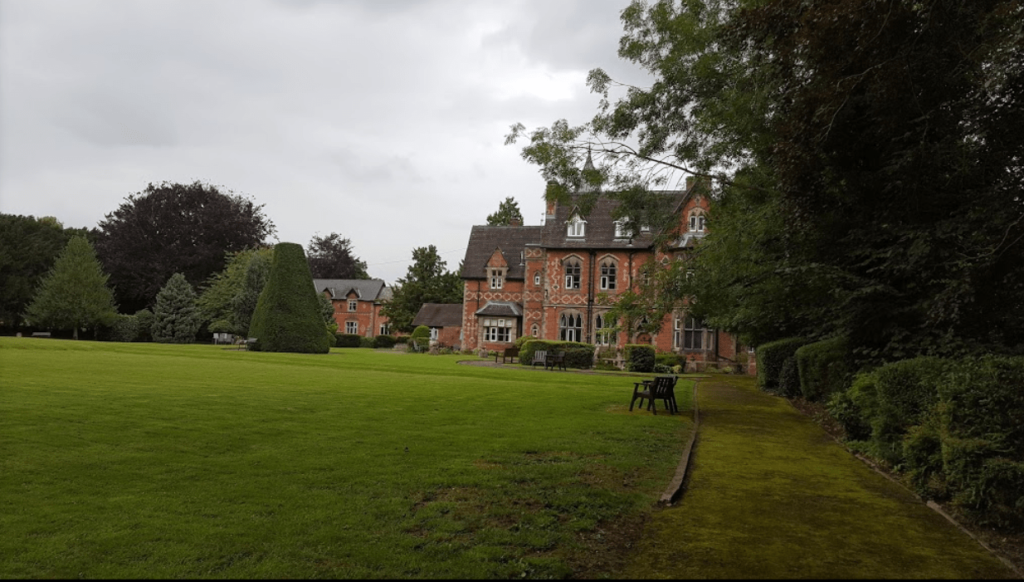
By V. Rev Canon Arthur G Wall (1968)
Aston Hall is situated in Aston, a village two miles south of Stone and about six miles north of Stafford.
The Hall is a delightful home for retired and convalescent priests. It contains bed-sitting rooms for eight priests who dine in community or in their own rooms if indisposed. There is an automatic lift to the bed-sitting rooms.
The Hall was purchased from Major Wenger in 1961 by Cyril Hartley, KSG, who gave it to the Birmingham Archdiocese as a guest house for retired and convalescent priests. Also, priests are welcome who wish to spend a little time and quietness in pleasant country surroundings. The Hall has a large garden, spacious grounds and a field; altogether about six acres.
There is a very charming chapel in the Hall, near the main entrance, which is part of the Passionist Church erected by Blessed Dominic Barberi CP.
The Hall is partly surrounded by a wide and deep moat (now dry). This gives some indication of the life of Aston Hall.
One of the glories of Aston is that with a few exceptions in recent times, it was always the home of good Catholic families. Old families like the Stanleys, Heveneninghams, Simeons and Welds were possessors. Early in the 19th Century there was a community of Franciscans, followed by Brigittine Nuns. Priests and sick living in the Hall find a great joy in living in a place hallowed by our grand old Catholic forefathers who kept the faith for us.
Father Benjamin Hulme was in charge of the Aston parish and lived in the Hall 1838-1842. Shortly after his arrival he was cleaning the Chapel when under the altar he found the lost relics of St Chad. These relics are now the glory of St Chad’s Cathedral, Birmingham.
In 1842 Father Dominic Barberi CP came to the Hall and lived there until his death in 1849. The Passionist Fathers stayed on for some years and finally went to Sutton, near Preston, taking with them the body of Blessed Dominic.
After the departure of the Passionists the Aston parish was served by seculars. Father Huddleston (later Canon) was appointed Parish priest. He pulled down the old Hall and built the present one, finishing it in 1855. Canon Huddleston died in 1871. In 1909 the Hall was sold to non-Catholics and remained in non-Catholic hands until Major Wenger bought it.
In the grounds is a Grade 2 listed Mausoleum of the Simeon family built around 1767. It comprises a stone-built central chamber with a moulded pediment and good doorcase in moulded dog-eared architrave with keyblock, pulvinated frieze, and segmental pediment; a small, square, rusticated bay at either side, each with moulded cornice and niche on return side.
From https://historicengland.org.uk:
It is a Grade II listed building with a couple of exceptions. The building includes work by two C19 architects of note – Charles Hansom and Edward Pugin. The Pugin house, designed when he was 19 years old, is one of the first of his independent works, the house designed by EW Pugin survives in largely original condition; The site on which Aston Hall stands has a long history of Roman Catholic worship in England and includes the site of the chapel where the bones of St Chad were kept from the Reformation until the C19 and part of the Passionist convent built for Saint Dominic Barberi.
The site is an ancient one with a large moat (now dry). In the C16 the site passed to the Heveningham family and from them to the Simeon family. In about 1757 Sir James Simeon built a family mausoleum to the south-west of the moat which survives (Grade II). The estate passed to the Roman Catholic Weld family who commissioned a design from John Tasker c.1798. This house was then given to the English Franciscans to serve as a noviciate, and Bridgettine nuns were in residence from 1829-37. In 1838 the bones of St Chad were discovered under the altar in the hall chapel, having been brought there for safekeeping from Lichfield Cathedral at the Reformation. In 1842 Dominic Barberi arrived from Italy and founded a Passionist novitiate at the hall. A small convent and chapel with a courtyard plan were designed and built for him by CF Hansom in 1847-9. Barberi was responsible for receiving John Henry Neman into the Roman Catholic church in 1845 and was himself beatified in 1963. Following Barberi’s death in 1849, the Passionists gave up the mission and the site was bought in 1855 by Rev. Canon Edward Huddlestone, who employed EW Pugin to rebuild the hall. It was one of his first independent commissions, following the death of his father, AWN Pugin. This, the present Aston Hall, appears to include an earlier range, which may have formed part of Hansom’s convent buildings. It was also extended in 1912 when the present dining room was built on the site of a former conservatory. Hansom’s convent building was built over a part of the moat and proved unstable. It was demolished in the 1880s and the present church was built to the north west of the moat. It is believed that salvaged features from the earlier convent were reused in the new Catholic parish church and form part of the rear wing of Pugin’s house of 1855. From 1959 the house has been owned by the Birmingham Roman Catholic Diocese and used as a guest house for retired and convalescent priests.
Details
A convalescent home, designed as a house, in 1855 by Edward Welby Pugin for Father Edward Huddlestone, and incorporating an earlier wing and material from a convent designed by CF Hansom.
MATERIALS: red brick laid in Flemish bond, with gault brick and blue brick decoration and ashlar dressings. The roof is of alternating bands of plain and fishscale tiles.
PLAN: the house has two stories with attics. The ‘pinwheel’ plan revolves around a central, open-well, staircase hall, which leads at ground floor level to three reception rooms. A corridor leads north-east and this is, at its further end, a part of the cloister walk of the earlier convent building by Hansom. Also converted from the earlier building are the lower stages of the former tower and the sacristies, which now serve as a chapel.
EXTERIOR: the house is decorated with white and blue bricks forming trellis patterns, the initials of Edward Huddlestone and the date 1855. Casement windows are largely of plate glass, set in generous ashlar surrounds. Several metal casements have been replaced with timber-framed substitutes. The south-west, garden front has a plank door with strap hinges, to right of centre with three trefoils to its fanlight. Above this is a lancet at first floor level. To right of is a projecting gabled wing with a two-storey canted bay to the ground and first floors and a two-light casement to the attic. To left of the door are two, three-light, ground-floor windows with cusped heads and at first floor level are two, two-light casements. The gabled dormer windows have decorative bargeboards and elaborate structural joinery. Each supports a wrought iron mace finial and the gabled wing has a weather vane to its apex. The left corner has quoins and these include a small niche which houses a figure of a saint at first-floor height. Recessed at left is a small, square turret with a parapet and a flat roof which has lancets to both floors, and at right of this is a lower wing with a square bay at ground floor level with hipped roof and a two-light, gabled semi-dormer window to the first floor.
The south-east front is formed of the 1855 building at left and a portion of the eastern range of the earlier convent building at far right. In between these is the dining room addition of 1912. The Pugin block at far left has two, two-light windows with mullions and transoms at left, divided by a projecting chimney stack. To right of this is a projecting wing with a canted bay to the ground floor, a three-light casement at first floor level and a two-light casement to the attic. The 1912 section is of three bays with a canted bay to the centre of the ground floor with a half-glazed door, flanked by two-light mullioned and transomed casements. The earlier portion at right has stone walling with four, two-light windows with cusped heads at ground floor level and a gabled first floor window.
The north-west front has two gables set beside each other. The left one is a later addition including walling from an earlier lean-to range.
The north-east, front has the projecting, earlier wing at left with a combination of stone and brick walling and cusped lights. The ground floor has been masked by a series of later-C20 additions, but the first floor of the 1855 house has a turret with square lower body which dies, via offsets to an octagonal upper body. This has brick walling and stone quoins and a lead candle-snuffer roof. To its left is the tall staircase window.
INTERIOR: the hall has an open-well staircase with moulded newels and chamfered balusters. Each tread end has a sunken trefoil panel. The hall fireplace has a richly moulded surround with Edward Huddlestone’s initials to a shield above the opening. Three other ground floor rooms all have a similar pattern of fireplace with the initials ‘EH’ to the jambs and the text ‘SOLI.DEO.HONOR.ET.GLORIA’. The chapel to the north-west of the house, which appears to be part of the tower and eastern range of Hansom’s convent building for the Passionists, has chamfered ceiling beams and joists. The north-east wall has an altar with a reredos formed of three recessed, arched panels, with figurehead stops, which may be salvaged from another location in the former convent building, perhaps the arches above the piscina and sedilia of the earlier chapel.
Pursuant to s1 (5) of the Planning (Listed Buildings and Conservation Areas) Act 1990 (‘the Act’) it is declared that the lift and lift shaft located in the stair hall and the range of buildings of C20 date, on the north-east side of the former service yard and including garages and an entrance lobby, are not of special architectural or historic interest.
Sources
Books and journals
Drinkwater, FH , Aston Hall by Stone, (1976)
Scarisbrick, JJ, History of the Diocese of Birmingham 1850-2000, (2008), 101
